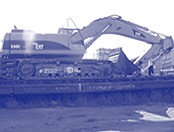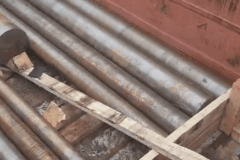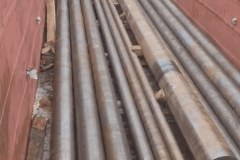Oversized (non-standard) cargo refers to shipments that surpass established maximum allowable dimensions, including length, height, width, and weight.
In railway transport, this classification includes loads exceeding 60 tons in weight, 14 meters in length (beyond the standard platform length of 13.3 meters), 3.25 meters in width, and 4 meters in height. However, the transport of such cargo faces restrictions due to a maximum weight limit of 500 tons, considerations for tunnel and bridge dimensions, and their carrying capacity.
Railway transportation emerges as the optimal solution for moving outsized cargo, particularly over medium and long distances. While trucks are often limited to a standard 20-ton capacity, railway transport can accommodate cargo of nearly any weight, up to 500 tons.
Simplextrans specializes in transporting outsized equipment from Turkey, Europe, South Korea to CIS countries (such as Kazakhstan, Russia, Tajikistan, Uzbekistan, etc.) and vice versa. This includes the transportation of construction machinery (excavators, bulldozers, graders, trucks), drilling rigs, earth-digging machinery, stone crushing machines, metal constructions, and large equipment (parts of cement and chemical factories, mills, etc.).
To initiate the planning of such oversized transportation, we require detailed drawings from the client. These drawings should encompass multiple projections indicating dimensions, weight information, the name of the goods, the planned route, and the volume of transportation.
The transportation process for outsized cargo is executed in several stages:
- Development of the lashing scheme for cargo on the railway car (platform, gondola wagon, transporter).
- Approval of the developed scheme in the Outsized Administration Department of the railway.
Below you can see how a designed securing scheme of the outsized cargo on the wagon looks like:
- File application for the loading plan and transportation coordination with all transit roads
- Purchasing of lashing materials
- Supply of the railway wagon to the loading branch, loading and cargo lashing in accordance with the agreed scheme
- In the case of transportation of special equipment – removal of headlights, wipers, batteries, etc. and their loading into the cabin, sealing glass and fragile items with protective material (plywood, plastic foam).
- In ports – preparation of the transit declaration, appearing as the sender on behalf of the sender (it is necessary to obtain a warrant of attorney from the sender)
- Processing of the SMGS rail bill and the loading list
- Delivery of cargo to the railway
- Payment of railway station charges (supply and cleaning of the railway cars, down time)
- Photographing of the cargo and the provision of photos of the performed work to the customer by e-mail
- In the case of special equipment – to make keys duplicate and send the second copy of the keys by express mail services. Since it often happens that keys are lost in transit, the consignee can not unload the equipment at the destination station. This implies huge costs for the down time and for the guarding of the railway cars waiting for the second copy of the keys.
- Guarding of cargo by the conductors who ride in a separate railway car (only on client’s request).
It is crucial to note that the processing time for obtaining permits, charts, fixtures, and dispatching cargo can range from 5 to 7 days (for ports) up to 3-5 weeks (for loading at inland stations). Therefore, clients are advised to declare the cargo for transportation in advance and provide all necessary documents promptly.
For oversized cargo transported from Turkey and Europe to CIS countries, our company ensures seamless delivery from the customer’s warehouse to the port, utilizing low bed trucks. Subsequently, transshipment to ferries, ships, or containers takes place, followed by delivery to ports in Ukraine, Russia, or Georgia. The cargo is then transshipped, secured on railway cars, and sent to the recipient’s address.
In certain scenarios, outsized cargo is directly delivered from Turkey to the railway station of the CIS, where it undergoes transshipment onto railway cars.
Below you can see some photos with oversized carriages performed by our company.
























